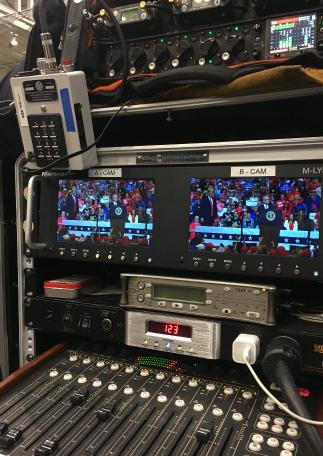 |
||||||
On the Presidential Campaign Trail |
||||||
www.televisionsound.com / Thom Shafer |
|
IFB - Working Live
One of my love's in the industry is working live. No take two's, you either get it right or you don't. I'm often asked to explain the wonderful world of IFB. It's a simple concept. Folding back program audio to the correspondents in the field minus their own voice. Hence the term mix-minus.
How best to explore IFB.... Perhaps some personal tales!
Back in 1995 I was covering the World Series for the David Letterman Show. This fine day we were on location just to put together a nice package piece when low and behold the show decided they wanted to do a live gag with 4 players and Sparky the young field reporter. The gag was to have Dave talk to the players and have them respond by hurling baseballs at the lens of the camera! Great bit but I had no IFB's with me! I ended up improvising to the 10th degree by converting Lectrosonics into wireless IFB's and utilizing 3 field mixers and splitters to get enough in's and outs to have a total of 5 wireless mics and 5 wireless IFB's! Well.... it started to rain, naturally, so I had to shove this whole jerry rigged wonder under an umbrella on the side of the field! It worked and not one player said a word to Dave.... but they could have!
The very next day I ordered my first set of Comteks!
This is the original post on IFB
I like to keep my old Shure FP-31 and FP-32 in my IFB kit to act as wonderful problem solvers. An example of this is how I rig into a sat truck. As you will find, not all satellite trucks are created equal. After you've had a bad one you'll always assume the worst!
There are two types of IFB feeds. Wet and Dry, these terms refer to the presents or absence of voltage on the line. Comteks don't like being hit with voltage so I request a Dry line for my rig. If the truck can't supply a dry line then the old Shure's come in to save the day! I rig the Shure anyways because it provides me with a great deal of control.
Example, Pam Oliver of Fox Sports wears two ears and likes to have her voice fed into her IFB so she can hear herself in the stadiums. This is easy for me on the field with the use of the Shure as a sub mixer. It also provides for hardwired IFB options with the additional outputs. Having control at your fingertips is a wonderful thing! (just remember to check all your batteries!)
Non Sat Truck IFB's are achieved with dialers. The rig is identical with the exception that now you're creating the telephone connection by use of a dialer. JK audio, Gentner Microtel and Advanced Communications Systems all make great products with internal dialers. The other avenue is the JK Audio That-2 paired with a normal telephone. In my opinion the That-2 is a must in any sound kit.
I was going to erase this page and publish a new updated version but I was struck by the pertinence of comparing the old with the new so I left it in tact below and added this brief update.
Mobility is the name of the game in live television now. I carry a dedicated IFB line in my bag via a flip phone and I'm able to be live any where, any time as long as I have cell service. I still, as always, feel very strongly that a sound mixer needs to hear IFB (program) to be able to mix appropriately. The mixer is every bit a part of the conversation and needs those cues such as a sudden deep intake of breath that indicates a loud remark is about to come.
In all my rigs whether I'm utilizing a cell phone or a land line dialer I input the phone into my mixer to give me ultimate control of the routing. For my monitoring I route the phone to my right ear in the headphones and for the talent the possibilities are endless. The same is true if I'm dialing two IFB's, I have a second headphone profile that I can scroll between to verify connection status. Why two IFB's? When you have an anchor in the field with guest two IFB's are required so that the anchor has a private line from the director that tends to be very active with a lot of information hitting the anchors ear. The guest don't need or want to hear all that and just need a standard mix minus that producers can jump in for cuing or cross talk interviews.
Working live is a pure joy and love of mine. I always mix listening in mono even if I'm not recording in mono. Thats how you develop great mixing chops and prevent yourself from being boned in post with someone just summing your tracks and hitting play.
IFB Kit
Lectrosonics T4-IFB Transmitter
Lectrosonics R1A Receivers
Lectrosonics R1B Receivers
Lectrosonics R1C Receivers
Audio Implements Ear's
ACS Dialers
JK Audio Remote Amps
Alcohol Swabs
JK Audio Remote Mix C+